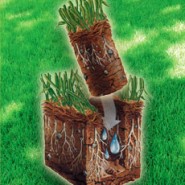 Lawn aerating is a way to supply the soil with air by poking holes in the ground throughout the lawn using an aerator. As a standard lawn care, frequent aeration reduces soil compaction and helps control thatch in lawns, helping water and fertilizer move into the root zone. Never aerating in extremely hot and dry and aerating frequently in heavy traffic areas.
Lawn aerating is a way to supply the soil with air by poking holes in the ground throughout the lawn using an aerator. As a standard lawn care, frequent aeration reduces soil compaction and helps control thatch in lawns, helping water and fertilizer move into the root zone. Never aerating in extremely hot and dry and aerating frequently in heavy traffic areas.
The best time for aerating is when actual cores or plugs of soil are pulled from the lawn. Holes should be two to three inches deep and no more than two to four inches apart. The day before aerating, you should thoroughly water the lawn to make sure plugs can be pulled more deeply and easily.
The followings are the means through which core aeration help make your lawn healthier
1. Improved air exchange between the soil and atmosphere.
2. Enhanced soil water uptake.
3. Improved fertilizer uptake and use.
4. Reduced water runoff and puddling.
5. Stronger turfgrass roots.
6. Reduced soil compaction.
7. Enhanced heat and drought stress tolerance.
8. Improved resiliency and cushioning.
9. Enhanced thatch breakdown.
Benefits of lawn aeration
Lawn Overseeding
Late spring, around May is the best time to aerate and spread seed for warm season grasses, like Bermuda. Aeration and overseeding will be good for cool season grass, like rye in the fall, around September.
Thatch
If you want your lawn to be healthier, you’d better eliminate your thick thatch by aerating. Thick thatch will lead to lawn disease, over-population of insects and water deprivation, so aerating when it needs to provide a healthy environment for your grass to grow.
Water Consumption, Oxygen and Fertilizer
Only when your lawn gets enough oxygen, water, fertilizers and nutrients can it keep healthy for a long. Aerating helps water to filter down through the soil to reach the root systems better and provides oxygen, fertilizers and nutrients to the root area.
Healthy Lawns
Aerating eliminates weeds such as crabgrass, providing enough water, oxygen fertilizers and nutrients to the lawn. So as a feature of unhealthy lawn, brown spots will never take hold with aeration.
Maybe you are puzzled by your lifeless lawn. No matter what you do, your lawn just doesn’t turn green. Try aeration, if you have a lot of traffic in your yard.
Soil compaction is the essential problem of lawn. If your left unmanaged, it will lead to lawn deterioration. Proper lawn care aeration can prevent this by:
1. Providing enough space for your lawn’s roots room to grow
2. Activating thatch-decomposing microorganisms in the soil
3. Providing for greater penetration of sprinkling and/or rain
4. Ensuring greater water, nutrient, and oxygen move in your lawn’s soil
5. Helping to prevent the run-off of fertilizer and pesticide from highly compacted areas
Click here to see what others are saying…